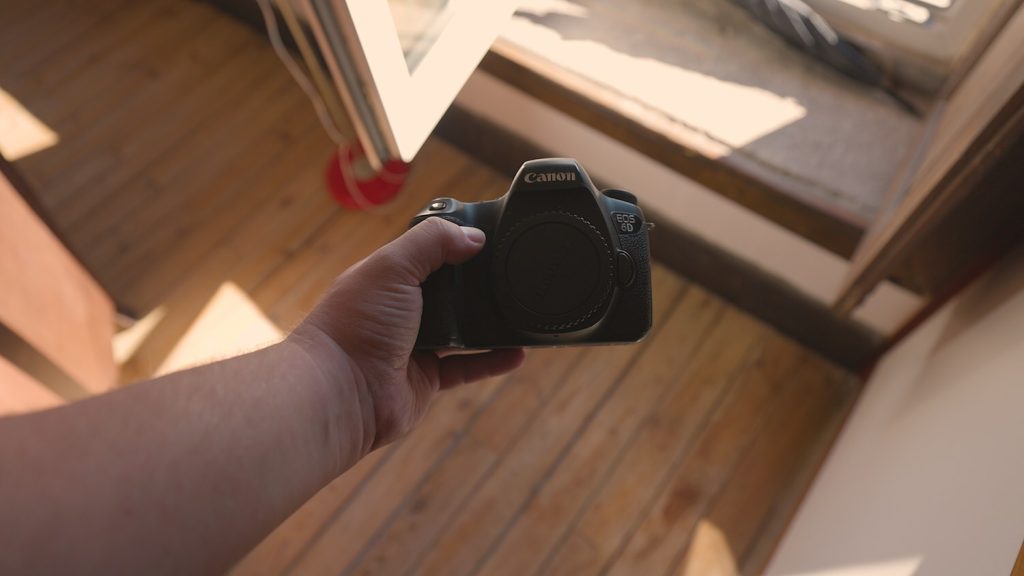This review will focus on two Canon cameras: the キヤノン6D そして Canon Rebel T3i, also known as the EOS Rebel T3i in the US and the EOS Kiss X5 in Japan. In this article, we will discuss the strengths of each camera as well as their respective issues.

サイズ
Let’s start with the portability of these two cameras. The Canon EOS 6D measures 144 x 110.5 x 74.6mm, or 5.67 x 4.35 x 2.94 inches, and weighs approximately 765 grams or 26.98 ounces. On the other hand, the Canon EOS 600D measures 133.1 x 99.5 x 79.7mm, or 5.24 x 3.92 x 3.14 inches, and weighs around 560 grams or 19.75 ounces.
Despite their weight differences, both cameras have similar physical sizes, making them relatively portable and compact. However, remember that these cameras’ portability can vary significantly depending on the lenses used.
Just so you know, I’ve reviewed quite a few lenses on my YouTube channel.
Now, let’s move on to the build quality of these two cameras. The Canon EOS 6D is constructed with aluminium alloy and polycarbonate resin, while the Canon EOS 600D is made of stainless steel, polycarbonate resin, and conductive fibre. I’d say that the 6D has a superior build quality compared to the 600D.
Now, onto the most important question – can these cameras capture great photos?

画質
The image quality produced by a camera heavily depends on the lens being used, but for the purpose of this review, let’s focus solely on the camera’s contribution to the image. We’ll begin by examining the sensors.
センサー
The Canon EOS 6D features a Full Frame CMOS sensor measuring 35.8 x 23.9mm, with a resolution of 20.2 MP. On the other hand, the Canon EOS 600D has an APS-C sensor measuring 22.3 x 14.9mm and with a resolution of 18 MP.
プロセッサー
Apart from the sensors, the camera’s processor also plays a significant role. The Canon EOS 6D has a DIGIC 5+ processor, while the Canon EOS 600D is equipped with a DIGIC 4 processor.
You may be wondering what the differences between the DIGIC 5+ and 4 processors mean for the cameras. The fifth generation DIGIC processor introduced several improvements, including a new High-Speed Burst of 10.3 frames per second, Full HD 1080p video, and Intelligent Image Stabilisation.
On the other hand, the fourth generation DIGIC processor provided faster image processing compared to previous models, improved noise reduction in high-ISO images, and H.264 1080p video recording capabilities.
国際標準化機構
Ok, what about the cameras’ ISO capabilities? The 6D has an ISO range of 100 to 25600, which can be expanded to 50-102800. On the other hand, the 600D has an ISO range of 100 to 6400, which can be expanded to 12800. Keeping the ISO on the lower end is generally recommended to avoid introducing unwanted noise in photos.
オートフォーカス
Regarding autofocus, the 6D offers up to 11 AF points, while the 600D has 9. Unfortunately, neither camera is equipped with Dual Pixel AF, which significantly enhances a camera’s autofocus capabilities.
A higher number of AF points and the presence of Dual Pixel AF would have greatly improved the cameras’ autofocusing performance.
シャッタースピード
Let’s talk about shutter speed and continuous shooting mode. Both the キヤノン6D そして キヤノン600D have a maximum shutter speed of 1/4000th of a second. This is useful for capturing fast-moving subjects.
For those looking to capture multiple frames quickly, continuous shooting mode is what you need. In this mode, the Canon EOS 6D can shoot at a speed of 4.5 frames per second, while the Canon EOS 600D can shoot at 3.7 frames per second. In other words, the Canon EOS 6D captures 4.5 photos within one second, while the Canon EOS 600D captures 3.7.
This feature is extremely useful for capturing fast motion, as the more frames captured per second, the higher the chance of getting the exact frame you want.

ビデオ
では、ビデオに関してはどうですか?
Both the Canon EOS 6D and the Canon EOS 600D are capable of recording at 1080p at 30fps and 720p at 60fps. Unfortunately, neither camera has the Canon Log function found in more expensive cameras, which provides a higher dynamic range.
Regarding image stabilisation, neither camera has built-in optical image stabilisation (IBIS). Although most cameras offer digital stabilisation, it is generally recommended to avoid it since the in-body digital IS is rarely great.
Moreover, digital stabilisation gets baked into the video, meaning that there is no backup of the video without it.
It’s best to film shaky footage and then stabilise it in software such as Adobe Premiere, as the software’s capabilities are always improving. I personally avoid in-camera digital stabilisation, as it is generally not as good as in-lens stabilisation.
If you want optical stabilisation, I would recommend using a lens such as the キヤノンEF-S 18-55mmキットレンズ with IS in the name. This lens offers in-lens stabilisation, which is superior to in-camera digital stabilisation.
Bear in mind that this lens is not compatible with both of these cameras, but we’ll discuss that in a bit.
ブログ
Cool, so can you use either of these cameras for vlogging?
It is possible to use almost any camera for vlogging, but there are some important factors to consider. It’s crucial to have a flip screen so that you can see yourself when the camera is facing you. With that in mind, the Canon 600D is a great choice because it has a flip screen.
However, the 6D doesn’t have this feature. A flip screen makes vlogging more effortless, and it also helps protect the screen’s surface when it’s not in use.
Another important aspect to consider is the type of sensor your camera has. The Canon 600D features a cropped APS-C sensor, while the 6D has a Full Frame Sensor. It’s important to note that a cropped sensor produces a more zoomed-in image compared to a full-frame sensor. Therefore, when using the 600D, it’s recommended to use lenses with shorter focal lengths. This is because many lenses may be too zoomed-in for handheld vlogging when you factor in the camera’s crop factor.
For handheld vlogging with the 600D, the 18-55mm kit lens would work well. You can zoom it all the way out to capture more in the frame. Additionally, if you opt for the version of the lens that includes Image Stabilization (IS), it will produce smoother video, which is beneficial in almost all scenarios.
If you’re looking for another option, the キヤノン24mmパンケーキレンズ is also a good choice as it is wide enough for vlogging. However, it’s important to note that this lens doesn’t have IS, so the footage may be shakier compared to using a lens with IS.

ユーチューバー
Now, if you plan on creating content where you can use a tripod, your lens recommendations will change significantly. In this case, lenses like the 18-55mm or the 24mm wouldn’t be the best options. Instead, you should consider the キヤノンEF50mm F1.4 または f/1.8 lenses.
These lenses can open up wider, which allows in more light, and they produce beautiful bokeh – that nice blurry background that people often desire.
It’s important to note that these lenses would not be suitable for handheld vlogging since they’re too zoomed-in and don’t have IS. If you’re interested, I have reviewed all of these lenses 私のYouTubeチャンネルあるいは you can read them here.
対応レンズ
Ok, so which lenses are they compatible with?
These two cameras are compatible with different types of lenses. The キヤノン6D is compatible with Canon EF lenses, including the EF 50mm f1.4 and the EF 50mm f1.8. However, it’s important to note that it’s not natively compatible with lenses like the EF-S 18-55mm kit lens.
In contrast, the キヤノン600D is compatible with both EF and EF-S lenses, including many of Canon’s more affordable options like the EF-S 18-55mm kit lens or the EF-S 24mm f2.8 ‘Pancake’ lens. With third-party lenses also being an option, you’ll have almost endless choices when it comes to compatible lenses.
ディスプレイ
ディスプレイについてはどうですか?
Both cameras have flippable screens on the back which are suitable for navigating menus and checking photos.
The Canon 600D features an articulated screen that can be used for vlogging, and it can also be turned around to protect its surface from scratches when stored in your bag. On the other hand, the 6D has a fixed screen that can’t be turned or moved.
In addition to its fixed screen, the Canon 6D features a small LCD on the top. While some people may not like how it looks, I find it aesthetically pleasing. This LCD also allows you to quickly and easily check your camera settings.

ストレージ
Right, so what about storage?
Unfortunately, neither the Canon 600D nor the 6D has a dual SD card slot. This feature is typically only found in higher-end cameras, not entry-level or mid-level models. The primary benefit of having a dual SD card slot is the ability to back up your photos in real time, with each photo being saved on both cards simultaneously.
This can be especially helpful for professionals, as it allows them to recover their work even if one of the SD cards fails.
While SD card failures aren’t common, they can still occur, even if you have multiple SD cards that you cycle through over time. Although the likelihood of an SD card failure is relatively low, keeping this possibility in mind is still important.
Having a dual SD card slot can also allow you to bypass the backup feature and use both cards separately. This effectively doubles your storage capacity, which can be especially useful if you’re shooting a large number of photos or videos.
コネクティビティ
Ok, what about connectivity?
The Canon 6D features Wi-Fi connectivity, but the 600D does not. However, neither camera has Bluetooth connectivity. As for NFC, the 6D has this feature, but the 600D does not.
I never use wireless connectivity, but I know some people do.
バッテリー寿命
If you are looking for a camera with a long-lasting battery, the Canon 6D could be a great option. With its LP-E6 battery, its charge can last for around 1000 shots. In comparison, the Canon 600D features an LP-E8 battery that can provide roughly 450 shots. So, if you plan on taking a lot of pictures while you’re on the go, it may be worth considering the 6D’s longer battery life.
It is important to note that several factors can impact the battery life of a camera, including screen usage, battery age, and temperature.
To ensure that you’re prepared for any situation, it’s always a good idea to carry a few extra batteries with you, especially if you’re working with a team. This will ensure that you can keep shooting even if your battery runs out of power.
アプリケーション
So, what are these cameras designed for?
Both cameras can do the job when it comes to portrait photography, street photography, product photography, landscapes, weddings, and events.
However, the lens you choose to pair with your camera is crucial for these types of photography.
On the flip side, things get a bit more complex if your photography involves shooting sports, wildlife, and documentary-style photos. While your choice of lens remains vital, it’s not the only factor to consider.
When it comes to sports and wildlife photography, a fast shutter speed and a high number of frames per second in continuous mode are ideal. If you want to revisit that information, you can refer to the Image Quality section of the review.
As for documentary-style shooting, either camera is suitable for photos. However, when it comes to video, things become more complex. To get more information about video capabilities, please refer to the video section of the review.

長寿
Cool. So how long will these cameras last me overall?
It’s worth noting that the Canon 6D has dust and moisture resistance sealing, while the Canon 600D does not have any weather sealing. Therefore, if you are using the 600D, you should be cautious and avoid exposing it to the elements too much.
アクチュエーション
In terms of actuations, both cameras are rated for around 100,000.
Due to the mechanical nature of cameras, they have a limited number of clicks they can perform before the mechanism starts to wear out. In the case of both the 6D and the 600D, this number is 100,000.
To clarify, every time you take a photo with the camera, it counts as one actuation. With both the Canon 6D and 600D rated for approximately 100,000 actuations, if you take an average of 10 photos per day, it would last you around 27 years before reaching its maximum limit.
However, it’s important to note that other components of the camera are also likely to fail before reaching this limit. Additionally, if you’re buying a used camera, it’s essential to check the camera’s shutter count to see how many photos it has already taken.
推薦の言葉
お役に立てたなら幸いです。私の他の記事もぜひご覧いただきたい。次のようなことに興味のある方なら、どなたでもご覧いただけます。 オーディオあるいは カメラとレンズ.ビデオレビューがお好きな方は、私のビデオをご覧ください。 YouTubeチャンネル.
最後に、この記事で紹介したすべてのアイテムを以下に掲載する。



